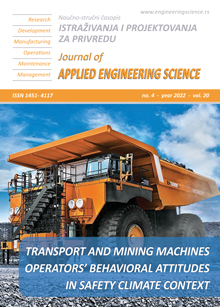THE USEFULNESS OF WAVELET TRANSFORMATION TO REDUCE NOISE ON VIBRATIONS OF CABLE STRUCTURES
Abstract
Vibration testing applications have been used to examine a structure’s dynamic behavior, such as determining the frequency values in cable structures. The accelerometer is used to record cable vibration data. Cable vibration data that has been mixed with noise has a non-periodic signal. In analyzing non-periodic signals using Fast Fourier Transforms analysis, there are obstacles in determining the reading of the frequency value. The study proposes a Discrete Wavelet Transform (DWT) to overcome the existing obstacles in analyzing the non-periodic signal. It can minimize the noise in the cable vibration data recording, making it easier to determine the frequency value of the cable structure, especially at the first vibration mode. In minimizing noises, the use of a scale factor of = 0.1 becomes the most effective value with the highest Signal Noise Ratio (SNR) value and the smallest Root Mean Square Error (RMSE). Other results obtained are Signal Noise Ratio (SNR) in the range of 2 – 5 dB, the type of noise in the cable structure is white noise and, the ratio of the standard deviation of noise (σ) to the amplitude (A) of recorded cable structure data with a range of 1 – 3.5.
References
Chen, S., and Zhu, H.Y. (2007). Wavelet Transform for Processing Power Quality Disturbances. EURASIP Journal on Advances in Signal Processing Volume 2007, Article ID 47695, 20 pages. https://doi.org/10.1155/2007/47695>
Gheorge, D., Chindris, M., Cziker, A., Vasiliu, R. B. (2010). Fundamental frequency estimation using wavelet denoising techniques. 3rd International Conference on Modern Power System MPS.
Hussan, M., Kaloop, M. R., Sharmin, F., Kim, D. (2018). GPS Performance Assessment of Cable-Stayed Bridge using Wavelet Transform and Monte-Carlo Techniques. KSCE Journal of Civil Engineering (0000) 00(0):1-14. DOI 10.1007/s12205-018-0438-3
He, C., Xing, J. C., Yang, Q.L. (2014). Optimal wavelet basis selection for wavelet denoising of the structural vibration signal. Applied Mechanics and Materials, vol. 578-579, pp. 1059–1063. https://doi.org/10.4028/www.scientific.net/AMM.578-579.1059>
Hidayat, I., Suangga, M., Soegiarso, R., Arumsari, P., Yuliastuti. (2020). Minimizing Noise in Sinusoidal Function Signal using Wavelet Transform. International Journal of Engineering and Advanced Technology., 2249 – 8958, Volume-9 Issue-2. DOI: 10.35940/ijeat.B2824.129219
Jain, P.K, Tiwari, A.K. (2017). An adaptive thresholding method for the wavelet-based denoising of phonocardiogram signal. Biomedical Signal Processing and Control 38 (2017) 388–399. https://doi.org/10.1016/j.bspc.2017.07.002>
Jing-yi, L., Hong, L., Dong, Y., Yan-sheng, Z. (2016). A New Wavelet Threshold Function and Denoising Application. Mathematical Problems in Engineering Volume 2016. https://doi.org/10.1155/2016/3195492>
Liu, T, Huang, J. (2021). Exponential estimation of the unknown frequencies of discrete-time multi-tone sinusoidal signals. Automatica, 129. https://doi.org/10.1016/j.automatica.2021.109698>
Liu, D. Y, Gibaru, O, Perruquetti, W. (2011). Parameter estimation of a noisy sinusoidal signal with time-varying amplitude. 19th Mediterranean Conference on Control and Automation. DOI: 10.1109/MED.2011.5983186
Morgenthal, G., Rau, S., Taraben, J., Abbas, Tajamal. (2018). Determination of Stay-Cable Forces Using Highly Mobile Vibration Measurement Devices. Journal of Bridge Engineering. American Society of Civil Engineers, ISSN 1084-0702. DOI:10.1061/(ASCE)BE.1943-5592.0001166
Pan, H., Lin, Z., Azimi, M., Yan, F. (2018). Time-Frequency-Based Data-Driven Structural Diagnosis and Damage Detection for Cable-Stayed Bridges. Journal of Bridge Engineering. American Society of Civil Engineers, ISSN 1084-0702. DOI:10.1061/(ASCE)BE.1943-5592.0001199
Shi, S., Min, H., and Ding, S. (2021). Observer-based adaptive scheme for fixed-time frequency estimation of biased sinusoidal signals. Automatica, Volume 127, May 2021, 109559. https://doi.org/10.1016/j.automatica.2021.109559
Tang, J.Y, Chen, W.T, Chen, S.Y and Zhou, W. (2009). Wavelet-based vibration signal denoising with a new adaptive thresholding function. Journal of Vibration and Shock, vol. 28, no. 7, pp. 118–121
Wang, J. X., Mao, J. H., Huang, A., Li, Q. (2016). Modal Identification of Sutong Cable-Stayed Bridge during Typhoon Haikui Using Wavelet Transform Method. Journal of Performance of Constructed Facilities. American Society of Civil Engineers, ISSN 0887-3828. DOI:10.1061/(ASCE)CF.1943-5509.0000856
Xie, B, Xiong, Z, Wang, Z, Zhang, L, Zhang, D, Li, F. (2020). Gamma spectrum denoising method based on improved wavelet threshold. Nuclear Engineering and Technology. Volume 52, Issue 8, August 2020, Pages 1771-1776. https://doi.org/10.1016/j.net.2020.01.025

